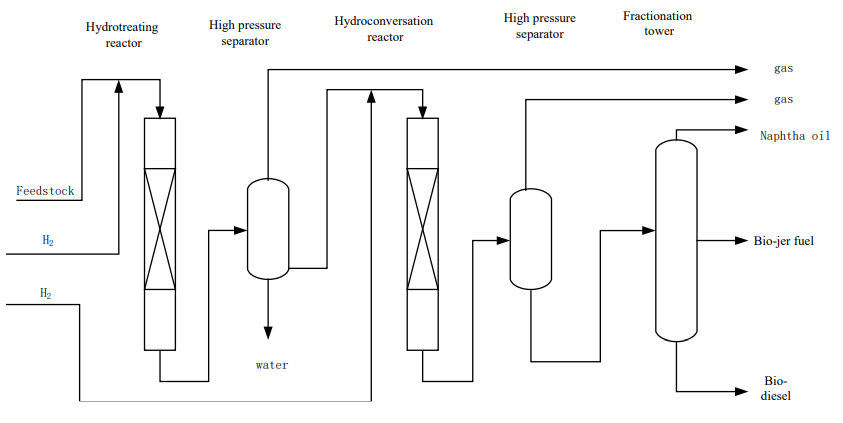1. Introduction
1.1 Technical Background
Aviation biofuels (also called bio-jet fuel) refers to the aviation fuels made from animal fats, forestry waste or other biomass. The properties of bio-jet fuel are equivalent to, some are better than, that of traditional aviation kerosene. Bio-jet fuel alone or blended with conventional fossil aviation kerosene can meet the power performance and safety requirements of aircraft, and the redesign of engine or aircraft is unnecessary. Moreover, airlines and airports do not have to develop new fuel transportation system. Bio-jet fuel can be directly used by aviation turbine engines. Nowadays, it is mainly applied as a blending component by volume of 1% to 50% with conventional fossil aviation kerosene.
Sinopec Bio-jet fuel production technology takes plant oils, animal fats, waste cooking oil, algae oil, fatty acids or fatty acid methyl ester as base material, through hydrotreating and hydroconversion, to produce jet fuel products with freezing point lower than -40 ℃.
1.2 Technical Process
Figure 1 is the process flow chart of Sinopec bio-jet fuel production technology. The mixture of oil and hydrogen is introduced into the hydrotreating reactor, and converted to the mixture of hydrofined oil, water, and gas through olefin saturation and hydrodeoxygenation with the presence of hydrotreating catalyst. The mixture is then separated into hydrofined oil mainly consisting of n-alkanes. Hydrofined oil and hydrogen are further introduced to the hydroconversion reactor, by selective cracking and isomerization reaction to obtain mixture with higher degree of isomerization and moderate distillation range. Bio-jet fuel is obtained by fractionation with some naphtha and biodiesel by-products production.

Figure 1 Flow schematic diagram of Sinopec bio-jet fuel production technology
1.3 Process Conditions
The process conditions of hydrotreating and hydroconversion reaction are shown in Table 1.
Table 1 Process conditions of hydrotreating and hydroconversion reaction
| Hydrotreating reaction | Hydroconversion reaction | |
| Reaction temperature/℃ | 300-400 | 320-400 |
| Hydrogen partial pressure/MPa | 4.0-8.0 | 4.0-8.0 |
| LHSV /h-1 | 0.5-4.0 | 0.5-4.0 |
| V(H2) /V(oil) | 600-1200 | 600-1200 |
2 Technical Features
2.1 Process characteristics
1) Based on the composition of plant oil and the quality requirements of the jet fuel, the hydroprocessing technology combining hydrotreating and hydroconversion to produce Bio-jet fuel from lipids was developed.
2) The unique processing method for catalyst carrier optimizes the selection of catalytic active component. The hydrotreating catalyst RJW-3 with excellent hydrothermal stability and hydroconversion catalyst RIW-2 with high selectivity were developed.
2.2 Flexibility of production
The turndown ratio could be 60% to 110% of the nominal capacity during normal production.
2.3 Adaptability of raw materials
Raw materials of the technology cover wide range, including various woody or herbaceous seed oil, waste oil, waste cooking oil, fatty acids or fatty acid methyl esters and algae oil.
2.4 Performance indices
The hydrofined oil, obtained from grease by hydrotreating to remove the oxygen and other heteroatom, only consists of C and H. after hydroconversion and fractionation, the jet fuel fractions obtained from hydrofined oil can meet all the requirements of ASTM D7566-17 and GB6537-2018 (Total Acid Value is not more than 0.015mgKOH g, Freezing Point is not higher than -40 ℃, the Sulfur Content is not more than 10mg/kg, the Nitrogen Content is not more than 2mg/kg).
2.5 Operation cycle
The unit operation cycle are shown in Table 2.
Table 2 Operation cycle of unit utilizing Bio-jet fuel technology
| Hydrotreating | hydroconversion | |
| Continuous operation cycle | ≮2 years | ≮4 years |
| Total catalyst life | ≮4years | ≮4 years |
3. Catalysts
The proprietary catalysts for Bio-jet fuel technology consist of protective catalyst series, hydrotreating catalyst and hydroconveration catalyst and the main physical properties of the catalysts are shown in Table 3 and Table 4.
Table 3 Properties of protective catalyst and hydrotreating catalyst
| Catalyst | RG-20 | RG-20A | RG-20B | RG-1 | RJW-3 |
| Catalyst activity types | Sulfidation state | Sulfidation state | Sulfidation state | Sulfidation state | |
| Metal element | Ni-Mo | Ni-Mo | Ni-Mo | Ni-Mo | |
| Physical properties: | |||||
| Specific surface area/(m2/g) | ≮90 | ≮90 | ≮90 | ≮90 | |
| Pore volume/(mL/g) | ≮0.50 | ≮0.50 | ≮0.50 | ≮0.50 | |
| Crushing strength/(N/mm) | ≮70 (N/particle) | ≮15 (N/particle) | ≮15 (N/particle) | ≮12 | ≮18 |
| Shape | Honeycomb cylinder | Raschig rings | Raschig rings | butterfly | butterfly |
Table 4 Properties of hydroconveration catalyst
| Catalyst | RIW-2 | RLF-10 |
| Catalyst activity types | Reduced state | Reduced state |
| Metal element | Pt | Pt-Pb |
| Physical properties: | ||
| Specific surface area/(m2/g) | ≮180 | ≮250 |
| Pore volume/(mL/g) | ≮0.30 | ≮0.40 |
| Crushing strength/(N/mm) | ≮12 | ≮13 |
| Shape | butterfly | butterfly |
4. Application
The Bio-jet fuel technology has been applied on the 20kta industrial unit. The aero engine bench test and flight test for Sinopec Bio-jet fuel were successfully completed in 2013.
The Bio-jet fuel technology has won the first production license of China by CAAC in February 2014. The first commercial domestic flight and cross-pacific flight were successfully carried out for bio-jet fuel produced by this technology in March 2015 and November 2017 respectively.

